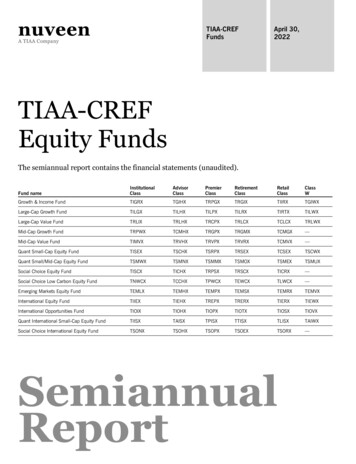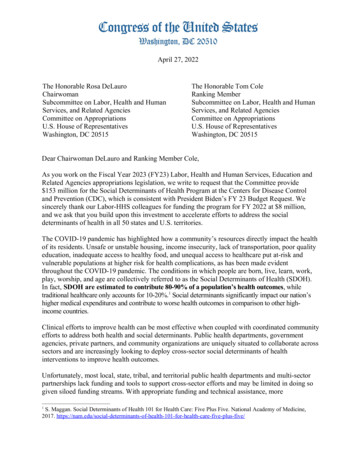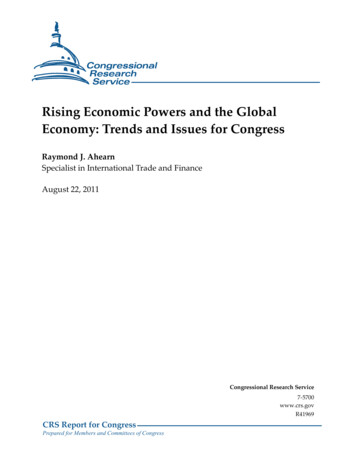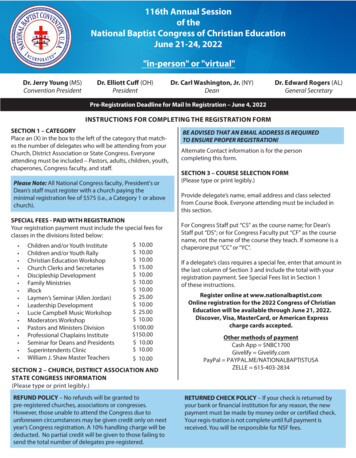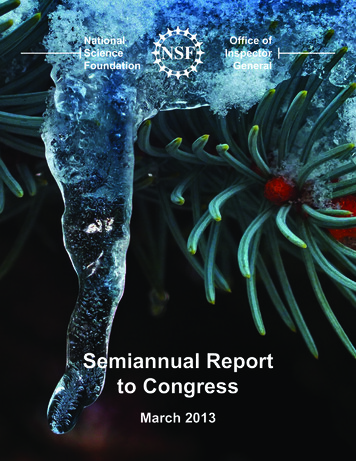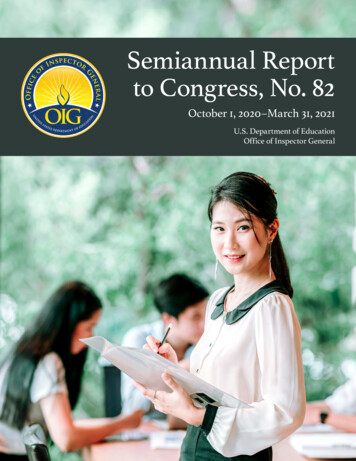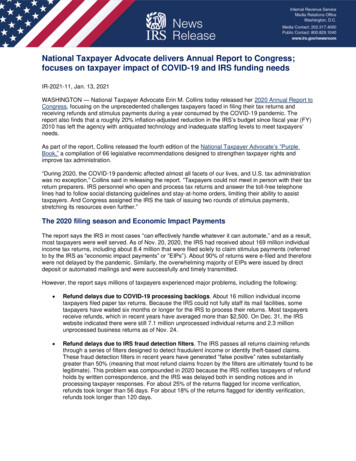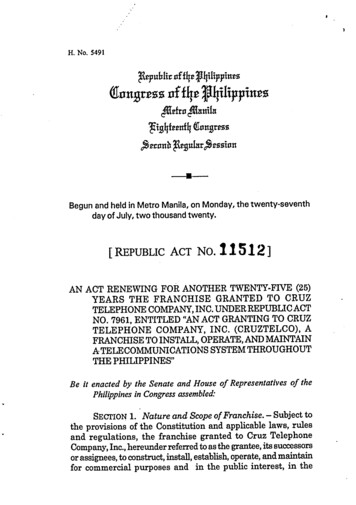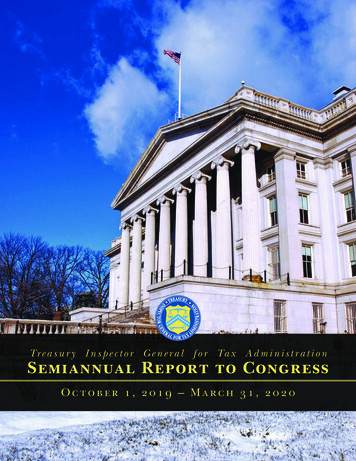
Transcription
Tr e a s u r y I n s p e c t o r G e n e r a l f o r Ta x A d m i n i s t r a t i o nSemiannual Report to CongressOctober 1, 2019 – March 31, 2020
Treasury Inspector General forTax Administration(TIGTA)TIGTA’s VisionMaintain a highly skilled, proactive, and diverse Inspector Generalorganization dedicated to working in a collaborative environment withkey stakeholders to foster and promote fair tax administration.TIGTA’s MissionProvide quality, professional audit, investigative, and inspectionand evaluation services that promote integrity, economy, andefficiency in the administration of the Nation’s tax system.TIGTA’s Core ValuesIntegrity – Maintain the highest professional standards ofintegrity, personal responsibility, independence, objectivity, andoperational excellence in pursuit of TIGTA’s mission.Organizational Innovation – Pursue innovative practices in organizational structure,operational programs and processes, audit, investigative, and inspection andevaluation methodologies, and the application of advanced information technology.Communication – Achieve effective organizational approaches andsolutions by encouraging open, honest, and respectful communicationamong TIGTA’s executives, employees, offices, and functions, aswell as between TIGTA and its external stakeholders.Value Employees – Respect the dignity, contributions, and work-life balance of ouremployees, and recognize diversity as fundamental to the strength of our organization.Commitment to Collaboration – Establish and maintain collaborative and professionalrelationships with other Government and non-Government stakeholders.
Trea sur y Insp ec t o r G e n e r a l fo r Ta x A d m in is tr a tio nSemiannual Report to CongressOctober 1, 2019 – March 31, 2020
This Treasury Inspector General for Tax Administration’s (TIGTA)Semiannual Report to Congress (SAR)is dedicated to the memory ofJohn F. Zimmerman, Jr.TIGTA’s SAR Program Coordinator
TIGTA SEMIANNUAL REPORT TO CONGRESSInspector General’s Message to CongressI am pleased to present this Semiannual Report to Congress,summarizing the accomplishments of the Treasury Inspector General forTax Administration (TIGTA) during the period October 1, 2019 throughMarch 31, 2020. This report summarizes some of TIGTA’s morenoteworthy audits, investigations, and inspections and evaluationsconducted during this reporting period in the pursuit of our steadfastcommitment to providing oversight of the Internal Revenue Service (IRS)and protecting the integrity of Federal tax administration.During this reporting period, TIGTA’s Office of Audit has completed18 audits, and its Office of Investigations has completed1,257 investigations. In addition, TIGTA’s combined audit andinvestigative efforts have resulted in the recovery, protection, andidentification of monetary benefits totaling more than 2.25 billion.On July 1, 2019, the Taxpayer First Act of 2019 was signed into law. This legislation aims to expandand strengthen taxpayer rights and to reform the IRS into a more taxpayer-friendly agency by requiringit to develop a comprehensive customer service strategy, modernize its technology, and enhance itscybersecurity systems and programs. One of TIGTA’s main areas of current emphasis, as reflected byan audit report described in these pages, is oversight of the IRS’s efforts to improve security overtaxpayer data and to protect IRS resources. TIGTA is working with the IRS to identify, investigate, andcombat threats to its cyberinfrastructure, focusing especially on how the IRS ensures that onlyauthorized taxpayers can access their information on public-facing applications.Similarly, TIGTA continues to investigate and deter high-profile attacks against online IRS applications,as part of its responsibility for investigating and deterring tax-related cybercrime and disrupting cyberbased schemes by illicit actors who seek to steal identifiers and impersonate taxpayers and IRSemployees.Like other Federal agencies, the IRS is being dramatically impacted by the novel coronavirus disease(COVID-19). TIGTA will review the actions IRS is taking to protect the health and safety of itsemployees and the taxpaying public. TIGTA will also assess the impact of the extension of deadlinesfor payments of taxes and the IRS’s ability to provide customer service, conduct examinations, andcollect revenue. TIGTA’s Office of Investigations continues to work with the IRS to prevent and detectany scams involving the COVID-19 stimulus payments made under the Coronavirus Aid, Relief, andEconomic Security Act of 2020. As always, we stand ready to continue to perform our responsibility ofserving the American people by protecting the integrity of Federal tax administration.Sincerely,J. Russell GeorgeInspector GeneralOctober 1, 2019 – March 31, 20203
Table of ContentsInspector General’s Message to Congress .3TIGTA’s Profile .Statutory Mandate .Organizational Structure .Authorities.6677Promote the Economy, Efficiency, and Effectiveness of Tax Administration . 8Security Over Taxpayer Data and Protection of IRS Resources . 8Implementing Tax Law Changes. 12Supporting an Enhanced Taxpayer Experience . 13Improving Tax Reporting and Payment Compliance . 15Protect the Integrity of Tax Administration .The Performance Model .Performance Area: Employee Integrity .Identity Theft and Insider Threats.Employee Integrity .Employee Integrity Projects .Performance Area: Employee and Infrastructure Security.Performance Area: External Attempts to Corrupt Tax Administration .Corrupt Interference .Scams and Schemes .Impersonation Scams .Tax Preparer Outreach .181818192021212323262630Advancing Oversight of America’s Tax System . 32Audit Statistical Reports .Reports With Questioned Costs .Reports With Recommendations That Funds be Put to Better Use .Reports With Additional Quantifiable Impact on Tax Administration .34343536Investigations Statistical Reports .Significant Investigative Achievements .Status of Closed Criminal Investigations .Criminal Dispositions .Administrative Dispositions on Closed Investigations .Summary of Investigative Reports and Criminal Referrals .Interference .Instances of Whistleblower Retaliation.Closed Investigations Involving Internal Revenue Service SeniorGovernment Employees .383839393940404040Inspections and Evaluations Statistical Reports . 42Reports With Significant Unimplemented Corrective Actions . 424October 1, 2019 – March 31, 2020
Ap p e n d i c e sAppendix I – Statistical Reports – Other . 44Reports With Significant Unimplemented Corrective Actions . 44Other Statistical Reports . 57Appendix II – Audit Products . 58Appendix III – TIGTA’s Statutory Reporting Requirements . 60Appendix IV – Section 1203 Standards. 63Appendix V – Inspector General Peer Review Activity. 64Appendix VI – Data Tables Provided by the Internal Revenue Service. 65Internal Revenue Service Memorandum . 65Report of Employee Misconduct Summary by Disposition Groups. 66Report of Employee Misconduct National Summary . 67Summary of Substantiated I.R.C. § 1203 Inquiries Recorded in ALERTS . . 68Glossary of Acronyms . 69October 1, 2019 – March 31, 20205
TIGTA’s ProfileThe Treasury Inspector General for TaxAdministration (TIGTA) provides audit,investigative, and inspection andevaluation services that promote economy,efficiency, and integrity in the administrationof the Internal Revenue laws. TIGTA alsoprovides independent oversight of mattersof the Department of the Treasury(Department or Treasury Department)involving activities of the Internal RevenueService (IRS), the IRS Oversight Board,and the IRS Office of Chief Counsel.Although TIGTA is placed organizationallywithin the Treasury Department and reportsto the Secretary of the Treasury and toCongress, it functions independently fromall other offices and bureaus within theDepartment.TIGTA oversees all aspects of activityrelated to the Federal tax system asadministered by the IRS. TIGTA protectsthe public’s confidence in the tax systemby identifying and recommendingstrategies for addressing the IRS’smanagement challenges and implementingthe priorities of the Treasury Department.TIGTA’s organizational structure (seefollowing page) is comprised of the Officeof the Inspector General and six functionaloffices: the Office of Investigations; theOffice of Audit; the Office of Inspectionsand Evaluations; the Office of MissionSupport; the Office of InformationTechnology; and the Office of Chief Counsel.6October 1, 2019 – March 31, 2020Statutory Mandate Protect against IRSemployee improprieties andexternal attempts to corruptor threaten IRS employees. Provide policy direction andconduct, supervise, andcoordinate audits andinvestigations related to IRSprograms and operations. Review existing andproposed legislation andregulations related to IRSprograms and operations,and make recommendationsconcerning the impact ofsuch legislation orregulations. Promote economy andefficiency in theadministration of tax laws. Prevent and detect waste,fraud, and abuse in IRSprograms and operations. Inform the Secretary of theTreasury and Congress ofproblems and deficienciesidentified and of theprogress made in resolvingthem.
Organizational StructureInspector GeneralPrincipal DeputyInspector GeneralDeputyInspectorGeneral forInvestigationsDeputyInspectorGeneral forAuditDeputyInspectorGeneral forInspectionsandEvaluationsDeputyInspectorGeneral elAuthoritiesTIGTA has all of the authorities granted under the Inspector General Act of 1978, asamended (Inspector General Act). 1 In addition to the standard authorities granted toInspectors General, TIGTA has access to tax information in the performance of its taxadministration responsibilities. TIGTA also reports potential criminal violations directly tothe Department of Justice (DOJ) when TIGTA deems that it is appropriate to do so. TIGTAand the Commissioner of Internal Revenue (Commissioner or IRS Commissioner) haveestablished policies and procedures delineating responsibilities to investigate potentialcriminal offenses under the Internal Revenue laws. In addition, the Internal RevenueService Restructuring and Reform Act of 1998 (RRA 98)2 amended the Inspector GeneralAct to give TIGTA the statutory authority to carry firearms, execute search and arrestwarrants, serve subpoenas and summonses, and make arrests as set forth in InternalRevenue Code (I.R.C.) Section (§) 7608(b)(2).5 U.S.C. app. (2012 & Supp. IV 2017).Pub. L. No. 105-206, 112 Stat. 685 (codified as amended in scattered sections of 2 U.S.C., 5 U.S.C. app.,16 U.S.C., 19 U.S.C., 22 U.S.C., 23 U.S.C., 26 U.S.C., 31 U.S.C., 38 U.S.C., and 49 U.S.C. (2012)).12October 1, 2019 – March 31, 20207
TPromote the Economy, Efficiency, andEffectiveness of Tax AdministrationIGTA’s Office of Audit strives to promote the economy, efficiency, and effectiveness oftax administration. TIGTA provides recommendations to improve IRS systems andoperations and to ensure the fair and equitable treatment of taxpayers. TIGTA’scomprehensive and independent performance and financial audits of the IRS’s programsand operations primarily address statutorily mandated reviews and high-risk challenges theIRS faces.The IRS’s implementation of audit recommendations results in: Cost savings;Increased or protected revenue;Protection of taxpayers’ rights and entitlements; andMore efficient use of resources.Each year, TIGTA identifies and addresses the IRS’s major management and performancechallenges. The Office of Audit places audit emphasis on statutory coverage required byRRA 98 and other laws, as well as areas of concern to Congress, the Secretary of theTreasury, the IRS Commissioner, and other key stakeholders.Audit Emphasis Areas for October 2019 Through March 2020 Security Over Taxpayer Data and Protection of IRS ResourcesImplementing Tax Law ChangesSupporting an Enhanced Taxpayer ExperienceImproving Tax Reporting and Payment ComplianceThe following summaries highlight significant audits completed in each area of emphasisduring this six-month reporting period:Security Over Taxpayer Data and Protection of IRS ResourcesActive Directory Oversight Needs ImprovementMicrosoft Active Directory is a Windows domain service that blends authentication,authorization, and directory technologies to create enterprise security boundaries that arehighly scalable. Security weaknesses in the Active Directory could allow unauthorizedaccess to critical IRS servers, applications, and account management. Without adequatelyprotecting Active Directory domain controllers, the IRS is unable to ensure that it canprotect sensitive taxpayer information.8October 1, 2019 – March 31, 2020
This audit was initiated to review the Active Directory Technical Advisory Board’seffectiveness in implementing TIGTA’s previous recommendations and to evaluate theeffectiveness and efficiency of the Integrated Submission and Remittance Processing(ISRP) Active Directory implementation.TIGTA has previously recommended that the IRS review the scope of the Active DirectoryTechnical Advisory Board’s defined oversight responsibilities and update the existingcharter to ensure that all individual forest owners (i.e., system owners) are appropriatelyrepresented on the Active Directory Technical Advisory Board. The IRS has implementedthese recommendations.This review of the ISRP’s implementation of the Active Directory found that computerrooms containing ISRP domain controllers lacked physical security and environmentalcontrols. TIGTA identified 15 physical security violations related to Limited Areas, 3multifactor authentication, fire safety and suppression, and emergency power shutoff.TIGTA also found that the ISRP Active Directory architecture lacked necessary logicalsecurity controls. For example, the IRS did not previously use credentials while performingvulnerability scans on ISRP domain controllers. When the IRS performed vulnerabilityscans using credentials at TIGTA’s request, it identified a 312 percent increase invulnerabilities. The IRS was also using an outdated application to perform securitycompliance checks.Further, the IRS improperly configured ISRP service and business role accounts. As aresult, TIGTA found more than 16,000 policy violations. Finally, the IRS inappropriatelyassigned business role accounts to an administrator group, resulting in those accountshaving unnecessary elevated privileges.TIGTA recommended that the IRS ensure that: Computer rooms are immediately updated to comply with agency and Federalrequirements;Credentialed scans are regularly completed;ISRP domain controllers with critical and high vulnerabilities are properlyremediated;Compliance checker applications use up-to-date guidelines;All ISRP business role accounts and service accounts comply with agencyrequirements; andSystem administrators have only one privileged account with domain administratorprivileges.TIGTA also recommended that the IRS: Physically separate the submission processing equipment from the ISRP domaincontrollers;3 An area in a building where access is limited to authorized personnel only. All who access a Limited Areamust have a verified official business need to enter.October 1, 2019 – March 31, 20209
Prioritize computer room upgrades to ensure access via multifactor authentication;andEstablish a process to review monthly vulnerability scan reports for credentialedscans.IRS management agreed with all of TIGTA’s recommendations.Reference No. 2020-20-006While Progress Is Being Made on Digital Identity Requirements, Completion Dates toAchieve Compliance With Identity Proofing Standards Have Not Been EstablishedAdvances in technology have provided the IRS an opportunity to be more responsive to thetaxpayer’s need for its services. However, a new set of challenges has emerged becauseinformation about individuals has become more widely available through social media andbreaches of Personally Identifiable Information (PII). As a result, the IRS needs to worktoward improving its public-facing applications to ensure that taxpayers who want access toIRS online services have verified their identities and can access IRS resources in a securemanner.This audit was initiated to evaluate the IRS’s identity proofing capabilities for secureelectronic authentication to online applications. Identity proofing is ensuring that users whointeract with an entity over open networks, i.e., the Internet, are who they claim to be.In June 2017, the National Institute of Standards and Technology issued updated guidanceon identity proofing in Special Publication 800-63-3, Digital Identity Guidelines. The IRS ismaking progress toward compliance with those guidelines on identity proofing bydeveloping and using a five-step process to determine the required assurance level foreach application and by creating a solution to ensure that the applicant is who they claim tobe within a stated level of confidence.However, the IRS may not complete its processes on all applications as scheduled, and itis using compensating controls that include identity proofing and authentication level ofassurances based on superseded guidelines for certain applications that require eitherremote or physical presence for identity proofing. While these compensating controls didnot fully meet the requirements, the IRS stated that they are the most secure methods toremotely identity proof and authenticate taxpayers until its new digital identity platform isimplemented, which is expected to be piloted beginning in June 2020.The IRS has 63 public-facing applications that taxpayers can access from the Internet. Asof July 2019, eight (13 percent) of these applications have completed all five steps of thedigital identity risk assessment process, while 17 (27 percent) applications have completedfour of the steps. The remaining 38 applications were not expected to complete all fivesteps until January 2020. However, TIGTA was concerned as to whether the IRS couldachieve that date given that it took an average of 217 calendar days to complete the eightapplications through step five.10October 1, 2019 – March 31, 2020
TIGTA recommended that the IRS: Ensure that the remaining public-facing applications complete all five steps in thedigital identity risk assessment process;Ensure that all testing for the digital identity solution is completed and all publicfacing applications are migrated to the implemented solution; andCoordinate with the Department of the Treasury on legislative proposals or policychanges needed to obtain additional assistance from States, territories, and Federalagencies that issue identifications in identity proofing users.IRS management agreed with two recommendations and partially agreed with the thirdrecommendation on the identity proofing issue.Reference No. 2020-20-012Actions Are Needed to Improve the Safeguarding of Taxpayer Information atVolunteer Program SitesThe Volunteer Program plays an important role in helping the IRS improve taxpayer serviceand increase participation in the tax system. The program provides no-cost Federal taxreturn preparation and electronic filing to underserved segments of individual taxpayers,including low-income to moderate-income, elderly, disabled, and limited English proficienttaxpayers. Because taxpayers who use return preparation services at volunteer sitesdisclose their PII, and identity thieves covet this information, the sites must safeguardtaxpayer information.Security over taxpayer data and protection of resources is a top IRS managementchallenge. This audit was initiated to assess the adequacy of, and adherence to, the IRS’svolunteer site requirements to safeguard and protect sensitive taxpayer information.TIGTA found that the Stakeholder Partnerships, Education, and Communication (SPEC)function worked with its partners to heighten awareness of data security at volunteersites. However, improvements were needed in some areas to strengthen the data securityprocesses. For example, the IRS’s partners participating in the Volunteer Program did notdevelop a written Information Security Plan (ISP) for each site. In addition, TIGTA’sunannounced visits to 20 volunteer sites identified multiple security weaknesses at eachsite. Finally, TIGTA found that procedures should be improved to reduce the risk ofpotential identity theft.TIGTA recommended that the IRS: Issue guidance to its partners requiring them to develop an ISP for each site;Require site coordinators to use the security feature included in the tax preparationsoftware to restrict volunteers’ access to prepared returns;Develop procedures to confirm that site coordinators are aware of securityrequirements;Ensure that site reviews include an assessment of compliance with security controls;Update procedures for partners to validate volunteers’ identity, using onlyGovernment-issued identification prior to participating in the Volunteer Program;October 1, 2019 – March 31, 202011
Reinforce training for SPEC function reviewers and site coordinators on how toreport volunteers who are caught violating the standards of conduct;Develop procedures to evaluate security incidents at Volunteer Program sites toidentify affected taxpayers whose information is at risk; andEmphasize to all volunteer program sites and partners their responsibilities toevaluate and report to the IRS all partner-owned and IRS-loaned lost or stolencomputers.IRS management agreed with all of the recommendations.Reference No. 2020-40-004Implementing Tax Law ChangesMany Organizations Are Not Notifying the Internal Revenue Service of Their Intent toOperate Under Internal Revenue Code Section 501(c)(4) as Required by LawOn December 18, 2015, the President signed into law the Protecting Americans from TaxHikes Act of 2015 (PATH Act), 4 requiring I.R.C. § 501(c)(4) organizations to notify the IRSof their existence within 60 days of their establishment. The PATH Act also includes theassessment of penalties on late filers and nonfilers and, in some cases, on the officialsresponsible for filing the notification. Implementation of the new notification requirementincluded the development of new forms and changes to information technology systems aswell as new guidance to help taxpayers comply with the notification requirement.This audit was initiated to assess the IRS’s efforts to implement the PATH Act provisionimposing a new notification requirement for certain I.R.C. § 501(c)(4) tax-exemptorganizations.TIGTA found that the IRS has not taken sufficient actions to identify noncompliantI.R.C. § 501(c)(4) organizations despite having various sources of information that wouldallow it to do so. Once an organization notifies the IRS of its existence, the IRS can usethis information to enforce compliance with the filing requirements for the annual return.TIGTA identified 9,774 organizations that were potentially required to file a notificationunder I.R.C. § 501(c)(4) but did not. These organizations and their responsible officialswere potentially subject to the assessment of more than 48.4 million and 47.5 million, respectively, in delinquency penalties. However, many of theseorganizations may not have understood or even been aware of the notification requirementbecause many of them filed other documents that informed the IRS of their existence.The IRS recently began assessing delinquency penalties on organizations that file theirnotifications untimely; however, it did not assess penalties on organizations that fileduntimely prior to February 2019. TIGTA identified 1,719 organizations that filed untimelynotifications before the IRS started assessing the penalty. These organizations and theirresponsible officials were potentially subject to more than 4.8 million and 3.1 million,4Pub. L. No. 114-113, 129 Stat. 2242.12October 1, 2019 – March 31, 2020
respectively, in delinquency penalties. However, some of these organizations may havehad reasonable cause for filing untimely notifications and may not be subject to the penalty.TIGTA recommended that the IRS: Determine the feasibility of working with State governments to identify neworganizations required to file a notification with the IRS;Conduct research on organizations identified by TIGTA and determine if anycompliance actions are necessary;Use available information to enforce compliance with notification requirements;Determine if untimely filers had reasonable cause for filing untimely or if assessingdelinquency penalties is warranted; andUpdate notices and procedures to fully implement the law.IRS management agreed to use available information to enforce compliance and updatenotices and procedures. The IRS did not agree to work with State governments, takeactions to bring organizations identified by TIGTA into compliance, or determine theapplicability of penalties for untimely filers.Notwithstanding the IRS’s disagreement with certain recommendations, TIGTA believesthat the recommended actions would improve the detection of noncompliant activity andensure more consistency in how the IRS enforces the law with respect to similarly situatedorganizations.Reference No. 2020-10-001Supporting an Enhanced Taxpayer ExperienceComplexity and Insufficient Oversight of the Free File Program Result in LowTaxpayer ParticipationThe Free File Program is a private-public partnership between the IRS and Free File Inc.,intended to provide online Federal tax preparation and electronic filing to economicallydisadvantaged and underserved populations at no cost to the individual or the Government.This program was first available in Calendar Year (CY) 2003 to help eligible taxpayers finda reliable tax software product that would not charge a fee.This audit was initiated in response to concerns raised by Congress and otherstakeholders. These concerns relate to whether the Free File Program is operating asintended and whether eligible taxpayers attempting to prepare and e-file their returns at nocost are diverted to tax return preparation services that are not free. The objective was toassess the IRS’s oversight of the Free File Program.The complexity, confusion, and lack of taxpayer awareness about the operation andrequirements of the Free File Program are contributing reasons why many eligibletaxpayers do not participate in the program. During Processing Year (PY) 2019, only2.5 million of the 104 million (2.4 percent) eligible taxpayers o
Active Directory is a Windows domain service that blends authentication, authorization, and directory technologies to create enterprise security boundaries that are highly scalable. Security weaknesses in the Active Directory could allow unauthorized access to critical IRS servers, applications, and account management. Without adequately
